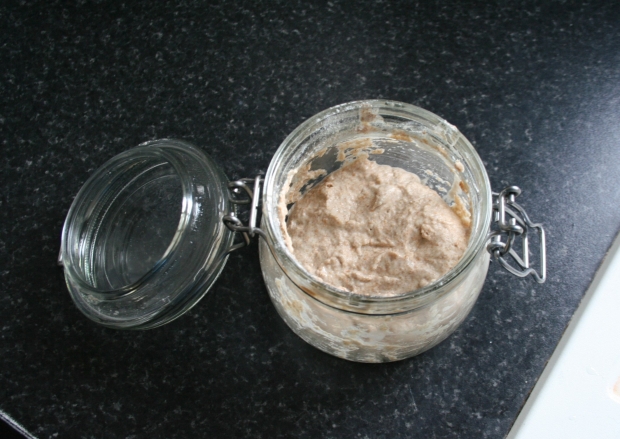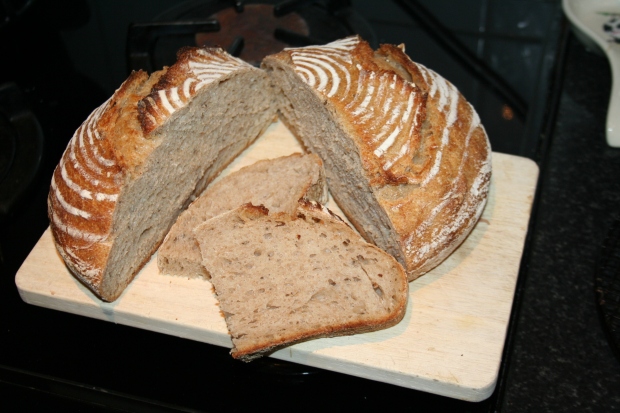When I first heard about sourdough about 2 years ago, I was intrigued but thought it would be too much trouble and would not fit my lifestyle. Feed a bacterial blob twice a day? You must be mad. But as time went on, the intrigue stayed and my lifestyle, or maybe just the view of what’s worth spending my time on, has changed.
When I saw that there would be a fermentation meet-up at the first Zero Waste Festival a year ago, I was ready. Ready to give proper, homemade bread a chance. After some wobbly beginnings and a few trials and errors, I found a way to keep the sourdough alive and myself sane.
Rest assured it was a bumpy ride – despite my efforts to consult Google in the hope of giving me an easy ‘how to’. I found several methods but none of them really fit my schedule. Then I came across Zero Waste Chef blogspot ‘How to Prevent Your Sourdough Starter from Taking over Your Life’ and that was it. Anne Marie is quite the chef and she uses sourdough regularly. Therefore she doesn’t store her starter in the fridge as I do. She also made up her starter from scratch. That might have been a step too far so I went with the safe method of getting it off someone who knew what they were doing. I believe that the starter was 20 years old when I bought it so now she’s a full-grown adult of 21 years. I called her Marjorie, just for fun.
It might have taken a while to get to where I am now which is because it needs a few shots to find out how your flour, water, bacteria and oven behave. It also depends on the time of the year – every fermentation is quicker in warmer weather – your sourdough starter might be ready after 6 hours when it’s hot outside rather than 8-10 hours when it’s not. Nevertheless, a year on, I am now happy with my sourdough bread and the occasional sourdough cake or pastry.
So, if you are a Monday to Friday working person and like the idea of having freshly baked bread at the weekend but don’t have time to attend to (and bake from) your sourdough starter every day, here is my regimen.
I keep my sourdough starter in my fridge in a flip-top jar. I usually keep about 90-100g of it at a time. Let’s this be Jar #1.
If I want to bake on Saturday during the day:

Sourdough starter taken out of the fridge
Thursday night (8-10pm): Take your sourdough starter (Jar #1) out of the fridge. Leave two tablespoons of the sourdough in the jar you store it in and transfer the rest into Jar #2 (or a suitable non-metallic container). Feed the Jar #1 with 40g of fresh flour (I use spelt wholemeal) and 40g of de-chlorinated water. I always keep a jug of normal tap water on my counter – the chlorine naturally dissipates after a couple of hours. Mix well together so that there is no loose flour and put aside on a counter-top. Put Jar #2 back in the fridge.

Freshly fed starter
Friday morning (8-10am): The mixture should at least double in size and show nice bubbles throughout. Repeat feeding the starter (Jar #1). Leave two tablespoons in the jar, add fresh flour and water, transfer the rest into your Jar #2 from the fridge. You can make so many delicious things from this ‘discard’ – I make Anne Marie’s crackers that I adjusted a little for our taste.

Fed starter after 8 hours
Friday night (8-10pm): Decide what you are going to bake the next day and how much leaven you will need. Prepare the leaven according to the instructions and set aside to be ready to bake in the morning. The leaven is basically just a lot of sourdough starter. Following the chosen recipe, combine starter from Jar #1 with fresh flour and water. You can now prepare your starter for the next week (Jar #1)– following the feeding method above. Put it in the fridge until next Thursday evening. If you forget to do this now, you can always do it tomorrow from the leaven. You can now also think what to make from the unfed starter in Jar #2.

Leaven ready for use and new starter
Saturday morning: Start baking. There are many many recipes on the web and in various cookbooks – start with what suits your taste the best.

The ready loaf 🙂
Saturday afternoon: Munch away!
Most of the time, I bake one loaf of sourdough bread which comes to about 1kg and that lasts us for a couple of days and keeps well (if stored properly)- for up to a week. I will publish the recipe shortly 🙂
Besides that, I always make the crackers from my Jar #2. Crackers, waffles, pancakes, crumpets….my brunch favourites!
Recently I also started to try making more things from the dough – different breads and filled pastries and cakes. My hands-down favourite is one with a milled poppy seeds filling. It’s a Slovakian thing 🙂
# I use spelt flour only for my sourdough starter but it’s up to you what kind of flour you use. It can be white wheat, whole wheat, spelt, rye. Every flour gives a different flavour and consistency to the starter. Some purists only use rye flour for rye bread or spelt flour for certain cakes and keep several jars of different starters at a time. Giving my simplifying tendencies, I only keep one starter. My bread recipe calls for rye leaven and strong white flour for the actual bread flour but I use my spelt starter with rye flour to make the leaven and it works perfectly.
# Feeding the starter three times to get the leaven works fine for me (and gives me enough discard to make the crackers) but if you don’t have time, some recipes make the leaven directly from the refrigerated starter. So even if you didn’t have time to do it a couple of times, you can still bake bread. Also the other way around – if your plans suddenly changed and you don’t have time to make the bread on Saturday morning, just feed the starter one more time and make the bread on Saturday evening or on Sunday morning. No stress 🙂
# If anything happens to your fridge starter (like, I don’t know, water from thawing chickpeas gets into it :)) and you still have some unfed discard in the fridge, you can easily revive it. You can also dry or freeze some starter for mishaps like these.
# A healthy starter smells sour but pleasant. If it gives off an acetone whiff, it’s no good – get a new one or resurrect some from your fridge discard jar.
# If your starter (or discard) develops a thin layer of black liquid on top, it’s not all lost. This is hooch – just pour it out and the rest is good as new.
# If a thin layer of velvety film appears on top, likewise, just scrape it off and throw away. This is kahm yeast, an unpleasant but harmless growth.
# But most importantly, do give it a try. Maybe it won’t be for you. On the other hand, maybe you will never go back to anything other than a good slice of sourdough bread.


I’ve had relationships that require less work than a sourdough starter. I think i’ll have to work my way up to one.
LikeLike
😂😂😂😂😂😂
LikeLike